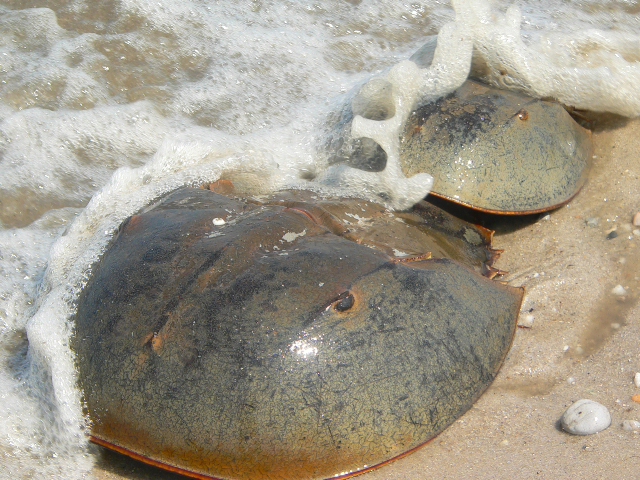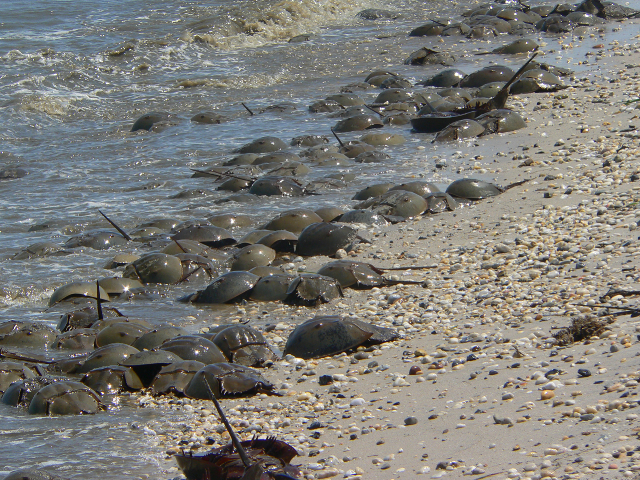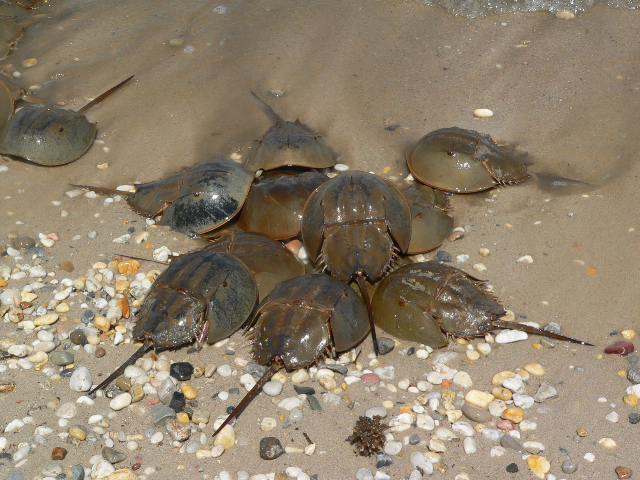| Twenty-eight people went on the horseshoe crab trip. We arrived at the St. Jones Reserve at 10 am. The Reserve is just to the east of the southern tip of Dover Air Force Base. It is one of 27 National Estuarine Research Reserves dedicated to monitoring coastal environments and to public education. This one is on property once owned by John Dickinson, a prominent politician in Delaware and Pennsylvania at the time of the American Revolution.
We were met by Kim Cole, Reserve manager, and given an introduction to the Reserve system in general and to the St. Jones location in particular. Then Kate Marvel took us out for a walk. We crossed a sizeable salt marsh on a boardwalk and went through woods and fields for a total of 1-¼ miles. The turnaround point was an historic but neglected building called Kingston-on-Hull. The brick section (“finest Flemish Bond Brick Work in Delaware”) dates from 1730s. It has been a general store, tavern, Kent County courthouse, and a brothel and had a frame second story added in 1859.
When we got back to the Reserve buildings, we had lunch featuring subs from Capriotti’s. Then Dick Weber gave us an introduction to his research on egg-laying by horseshoe crabs. We learned that females carry 20,000 – 60,000 eggs in the horseshoe of their carapace – that seems to explain why females are larger than males. In the high tides around spring full moons, females come up on the beach to lay their eggs. During the heaviest part of the spawning season in Delaware Bay, crabs begin to spawn as much as two hours before peak high tide. They only spawn as long as the tide is rising, because they need wet sand, so they can burrow efficiently. As the tide begins to fall, most females dig out and return to the water. A few remain burrowed into the beach until the next flood tide. One male will be clasped onto the female and very likely another 4-6 other males will be closely gathered around her. The one male is capable of fertilizing 100% of her eggs, but an auxiliary male can get up to 40% of fertilizations if he wedges himself into the right place. All that fertilization happens in a few minutes – what a place to look for sperm competition!
 A female bulldozes down into the sand and releases a few thousand eggs at a time, packing them into a mass that sticks together in a lump – looking like a wad of Play-Dough you’d squeezed in your fist. Then she pushes on, less than a foot, and repeats the process. She does this a few more times and may be nearly hidden under the sand while she plows on. When she is finished for this particular tide, she turns and heads back into the water. She will repeat the whole event on successive high tides until her eggs are gone. A female bulldozes down into the sand and releases a few thousand eggs at a time, packing them into a mass that sticks together in a lump – looking like a wad of Play-Dough you’d squeezed in your fist. Then she pushes on, less than a foot, and repeats the process. She does this a few more times and may be nearly hidden under the sand while she plows on. When she is finished for this particular tide, she turns and heads back into the water. She will repeat the whole event on successive high tides until her eggs are gone.
We saw photos of how much of a beach gets churned by the crabs when they are dense. Over a few tide cycles they disturb the majority of the beach. On successive high tides the crabs will churn up some of the egg masses that were deposited previously. These are the eggs the migrating shorebirds feast upon.
Dick also showed us the “turbulator” he invented for quantifying eggs. It is ridiculous to count them individually, though that is what people used to do. He measures them volumetrically after separating eggs from detritus and sand with his device.
When we left the Reserve to go to Pickering Beach, Dave Carter joined us for the short bus ride. Dave is Environmental Program Manager for the Delaware Department of Natural Resources. He was responsible for buying the St. Jones property and building the facility there. He also hired Dick Weber (retired entomologist from UD) to do the horseshoe crab research. The story behind this is fascinating. In the mid-90s, the Sierra Club sued to stop beach replenishment, which is done by dredging offshore sand and pumping it back onto beaches that have been eroded by storms. The motivation for dredging is political, of course, driven by the demands of the homeowners in the little communities that line the shore of Delaware Bay. The Sierra Club argued that dredging interfered with horseshoe crab egg-laying, and thus put the migratory shorebirds, especially the red knot, in danger because the birds require the eggs to fatten up for their trip to the Arctic to nest.
Dave’s reaction to the lawsuit was to say we really don’t understand the situation well enough to manage it scientifically. He enticed Dick Weber out of retirement to do the research. In 12 years Dick has learned a lot and is still at it. The Sierra Club accepted the research approach as long as Dick’s notebooks were open to them to inspect. As it turned out, beach replenishment benefits the crabs and the birds – on the other side of Delaware Bay, New Jersey has stopped beach replenishment and they have lost the beaches and the crabs and birds. (This is not the end of the story on beach replenishment according to Dave Carter. His staff is carefully documenting sea level rise due to global warming and it appears that dredging and replenishment is becoming more and more futile and the Bay-side houses will be claimed by the water.)
Since Dave is a tireless campaigner, he exhorted us a bit about how academia is in danger of becoming irrelevant. Research universities don’t generally recognize or reward regionally important, targeted research of the kind that Dick Weber is doing. It’s something for us to think about – there are job opportunities for research-trained people, like our students, outside of conventional academia; research-based environmental management, for example, is going to be important in the future.
When we got to Pickering Beach, the party really began. The crabs were there – females with their clusters of males, just as in the pictures Dick showed us. So were three more experts, to tend to our needs. Gary Kraemer is an Aquatic Resource Educator for Delaware Fish and Wildlife. Mike Oates is an independent video documentarian who has been documenting the crab/bird phenomenon for over 20 years. Jeanne Covert is a volunteer, and all three of them have been involved with the horseshoe crab research and tagging projects for years. These are the people who do the census work around monthly high tides in the spring, as well as the tagging efforts. They invited us to try out all aspects of horseshoe crab field ecology.
 
Mike had tagging materials and ABLE jumped in. People waited in line with their crabs to get to the tagging station. We measured and tagged 50 crabs in total. There was a lot of beachcombing, along with the search for animals that had been tagged at some earlier time. Gary and Mike set us a challenge of finding one of the crabs outfitted with a radio transmitter – that would be the big prize. And what do you know? – after two hours or so, Rick Scott walked up to the tagging station with a crab with a transmitter! This caused quite a lot of excitement on everyone’s part. The transmitter was put on in March of 2004 and though it was no longer working due to dead batteries and a missing antenna, there will be records of this crab’s movements for the period when it was operating. We will get those data and post them on the ABLE website. Mike Oates says 16 million is a good estimate for the total number of crabs in the Bay during spawning, and only 300 radio tags of the kind Rick found were put on crabs originally, so the find Rickey made is extraordinary.
Mike’s take on the crab situation is that they have never been in danger. The population was depressed some in the 90s due to heavy harvesting for use as bait in whelk and eel traps, but next year will be the 10th season since limits were put on the harvests. Females take 10 years to mature and Mike thinks we’ll see large numbers come ashore to lay eggs next season. He noted that they’ve already seen a jump in number of males this year – males mature in 9 years. He thinks the harvesting restrictions should be eased for the sake of the fishermen and that we’re about to be inundated by a resurgent horseshoe crab population.
After we’d been on the beach a couple hours there were storm clouds gathering and we left Pickering for the Aquatic Resources Education Center. This is Gary Kraemer’s home base. On another day we might have taken advantage of the opportunities for exploring outdoors but this time we went inside to continue learning about horseshoe crabs. What we saw were samples of an extensive set of curricular materials called Green Eggs and Sand. Mike created the videos that go with the curricular activities, and Gary, Mike, and a great many teachers created those activities over the last ten years. As Gary explained, when they started in 1999, they thought it would be a one or two year project, but it has just continued to grow. Teachers come from all over (21 states and 4 countries) to take a 2 ½ day workshop on horseshoe crabs and Green Eggs and Sand before they get the teaching materials. Mike explained that this is necessary because they don’t want teachers spreading misinformation and misunderstanding.
In the segments we saw, we met Thumper, a local fisherman who is committed to conservation. He invented a bait bag that is very effective in catching whelk but uses only a small fraction of the horseshoe crab bait used in earlier trapping methods. Unfortunately, Thumper is one of the people whose income has been severely curtailed by the limitations on crab harvesting. Here was another perspective on the importance and value of a scientifically sound base for resource management.
Another segment of Green Eggs and Sand was about the medical products industry that has been built up around the horseshoe crab. Proteins packaged in amebocytes in horseshoe crab blood are exquisitely reactive to endotoxins produced by Gram-negative bacteria. We saw a photo of an injured crab with a gray, gel-like agglutination reaction along a crack in its shell. We also saw the bleeding operation, which amounts to bending the crab at the main hinge and inserting a needle into the heart, catching the fluid in a bottle until the agglutination reaction stops the flow. Apparently the survival rate from bleeding is very high, though some crabs are lost to injuries when the collection method involves dredging.
We learned that virtually every piece of medical equipment or anything placed inside or injected into the human body – needles, artificial limbs, injectable pharmaceuticals, and vaccines - sold in the US and Canada has been tested for sterility by the Limulus test, which is apparently still much more sensitive that any other methods devised to date. Gary gave us single-test vials of LAL (Limulus amebocyte lysate) to take with us. He described an activity in the GE&S curriculum that involves use of the LAL vials to test for the presence of endotoxins in waters of various kinds. They require only adding a .25 ml sample of the water to be tested to the LAL in the vial and watching for the agglutination reaction. He told us that most natural water sources (stream, pond, ocean, aquarium, etc.) will yield a positive gel-test and it is not uncommon to get a positive reaction to tap water or bottled water.
It was time for dinner, so we got on the bus again and headed to Sambo’s in Leipsic. Gary, Mike, Jeanne, and Jim, our driver, joined us for dinner. Sambo’s is a tavern, not a restaurant, but the food is great. It is a seafood place with a specialty of blue crabs and beer. There are maps of the world on the wall with pins showing where customers have come from. ABLE was able to add to the collection. We got back to Newark just before 10 pm.
|